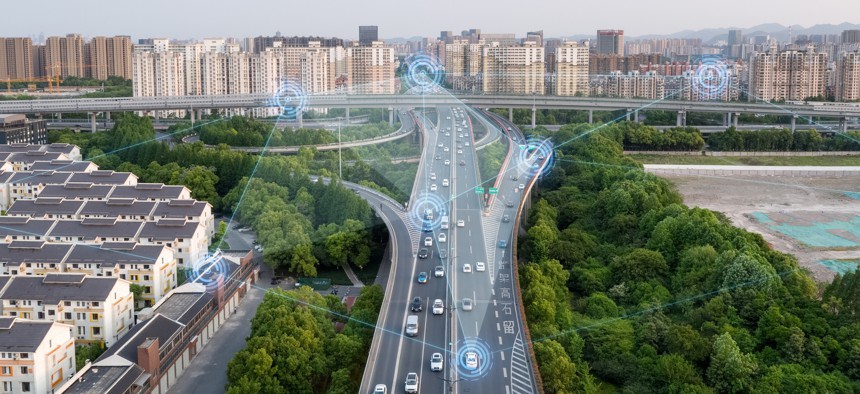The data platform behind intelligent transportation

GettyImages/dowell
The stream of enriched data from connected vehicle devices and intelligent transportation systems will support scores of applications drawing on real-time and historic analysis of road and traffic conditions.
The Florida Department of Transportation (FDOT) is developing a connected vehicle data exchange platform (DEP) to help analyze real-time road conditions and communicate travel information to drivers.
FDOT tapped Southwest Research Institute (SwRI) to develop a cloud-based vehicle-to-everything (V2X) DEP as part of the department’s Connected and Automated Vehicles (CAV) Initiative. The $8 million project is expected to take four years.
“The V2X DEP is intended to encompass the FDOT’s operational, in development and planned CAV project corridors and networks,” Alecia Collins, FDOT deputy communications director, wrote in an email to GCN. “The system plans to ingest data from CAV devices and intelligent transportation systems … to assist with decision-making by FDOT and stakeholders in the auto industry, research, traffic engineering and other transportation areas.”
One element of the platform is roadside radio units that will use short-range point-to-point communication to connect with vehicles as they drive by.
“From there, that data has to travel along a backhaul to a Florida DOT traffic management center, and then from there it’s got to travel over the public internet to reach this cloud-hosted data-processing platform,” said Dan Rossiter, assistant program manager for research and development within SwRI’s transportation technologies division. “At that point, the data is going to be consolidated, duplication is going to be removed [and] personally identifiable information is going to be stripped out to ensure anonymity for the traveling public.”
Collins emphasized data privacy and security, too: “PII will not be a part of the data exchange platform. The V2X DEP follows Florida’s cybersecurity standards and incorporates them in the design to ensure that security is properly maintained through the ingestion, storage and dissemination of data," she said. "Depending on the access level, the V2X DEP user will need authentication credentials to utilize the system.”
After it’s cleaned, the data will be reconciled with the broader dataset, which includes data from other sources such as traffic cameras, proprietary cellular-based communications from various vehicle manufacturers and third-party data feeds. All of that needs to look the same so SwRI’s algorithms can work with it, Rossiter said.
“This stream of enriched data will be the basis for real-time and historic analysis, leveraging a combination of machine learning and traditional algorithms,” Collins said.
The department needs little on-premises hardware to support this, Rossiter said, because the idea is to use the cloud to provide most of the compute and storage capacity. “The reason for that is that managing the servers necessary to support this effort would be cost-prohibitive. The economies of scale we can get out of putting the technology in the cloud can’t be beaten,” he said.
Additionally, the system will autonomously scale its ability to process data as the volume increases. In 2021, there were about 84 million connected cars on U.S. roads, but that number is expected to pass 305 million in 2035, according to Statista.
The project is structured to have five iterative releases over its four years. It’s currently in a proof-of-concept to demonstrate feasibility, and although it’s intended for statewide deployment, Rossiter said it will likely kick off in just a few districts.
“One of the big driving factors that I suspect will be a big part of figuring out who ends up going first is who has connected vehicle deployments today – some districts have more today than others," he said. "The other part of that is connectivity. There’s some work needed to establish secure connections between Florida DOT facilities and the cloud, so there’s the virtual-private networks that are going to be established to enable the data that doesn’t want to be on the public internet and needs to be secure to travel securely, and that does require some IT effort on the ground.”
SwRI has identified about 100 use cases for the DEP, he said, such as determining weather conditions based on snapshots from traffic cameras. “Now every single traffic camera along the road is basically a weather sensor as well, and so you can make that data available and push it out for others to consume,” he said. For instance, a downpour in one area might influence travel plans.
SwRI and FDOT have partnered with other organizations, too, including Amazon Web Services, Google, several original equipment manufacturers, and logistics and fleet companies. Ford Mobility will supply V2X data from its connected vehicle platform, and Iteris, a smart mobility infrastructure management company that has worked on other CAV and V2X deployments, joined the project last month.
The team will also provide the clean, high-volume data to researchers at Florida International University who can perform historical analysis to see patterns over time. “If we have this store of data, suddenly the opportunities to figure out interesting patterns that exist within it emerges,” Rossiter said. “From there, the sky’s the limit in terms of what you can do.”
Stephanie Kanowitz is a freelance writer based in northern Virginia.





